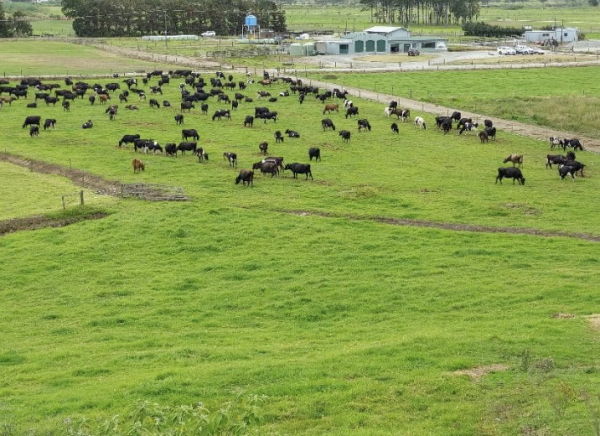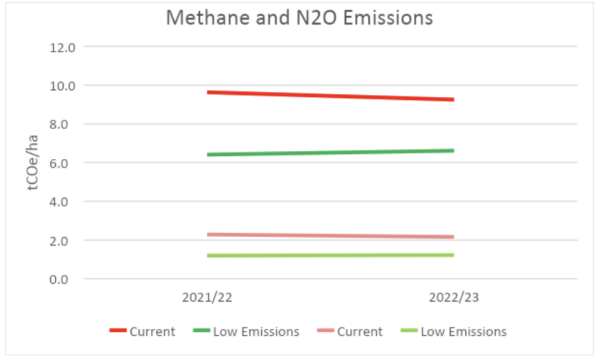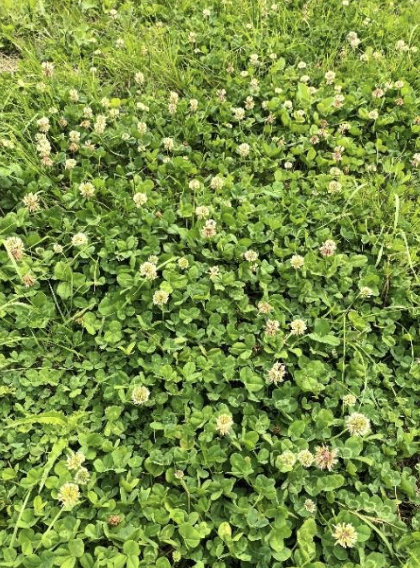Northland Agricultural Research Farm (NARF), Dargaville
NARF is an 85-ha dairy research farm located two km west of Dargaville, which is owned by all Northland dairy farmers through an incorporated society. Ninety percent of the farm sits on the flat marine soils of Kaipara clay, with the balance on Te Kopuru sand. Both soil types are extremely wet during winter with high pugging risk.
Video
Overview

The farm is set up to run farm system trials and is currently running a Future Farming Systems trial which began in June 2021. There are three 27.5-ha farmlets which compare production, profit and emissions over a four-year period. The farmlets are focussing on adaptation to climate change through alternative pasture species, and mitigation through farm system changes targeting reduced Greenhouse gases (GHG) emissions.
NARF is run by a dedicated committee of farmers who meet every fortnight to set farm management plans, with oversight from the Northland Dairy Development Trust (NDDT) Science Manager. The goal is to provide realistic practical information which other farmers can use in their own businesses. Effects on production, profit, environment, and people are measured and reported, and visitors to the committee days are welcome.

What changes have been made?
Leading dairy farmers in conjunction with the science community have designed and run the farm systems in response to farmers asking questions about the cost of lowering GHG emissions.
There is a control farm (Current Farm) which is typical of Northland farming systems which is used to compare results against. The Current Farm runs 3.1 cows/ha on standard kikuyu/Italian ryegrass pastures, using up to 190 kg Nitrogen(N)/ha. The Alternative Pastures Farm has over 70 percent of pastures in other species, primarily tall fescue and cocksfoot, and also runs 3.1 cows/ha and uses up to 190 kg Nitrogen/ha. The Low Emissions Farm is designed to achieve 25 percent reduction in methane and 50 percent reduction in nitrous oxide compared to the Current Farm. In order to achieve this the stocking rate has been reduced to 2.2 cows/ha and there is no applied Nitrogen (N) fertiliser.
Table 1. Farm Physical Parameters for 2021/22 and 2022/23
|
|
Control Farm |
Low Emissions Farm |
||
|
|
2021/22 |
2022/23 |
2021/22 |
2022/23 |
|
Area (ha) |
27.5 |
27.5 |
27.5 |
27.5 |
|
Peak Cows milked c/ha |
3.1 |
3.1 |
2.15 |
2.3 |
|
Milk Production (kg MS/ha) |
1268 |
1204 |
794 |
910 |
|
kg N/ha fertiliser applied |
171 |
188 |
0 |
0 |
|
Imported feed kg DM/cow |
809 |
715 |
67 |
163 |
Why were the changes made?
Farmers were worried about climate change, particularly in Northland where the effects are felt first. Ryegrass pastures do not persist, and kikuyu is spreading with associated management costs. Kikuyu pastures are not productive during cool weather so require mulching and undersowing with Italian ryegrass in order to boost growth during winter and spring. Farmers wanted to know whether there are other pasture species that are more persistent and profitable.
At the same time, the industry is being encouraged to reduce methane and nitrous oxide emissions. Farmers wanted to know whether they could achieve significant reductions using farm management changes and what the effect on their profit would be.
In order to meet the large GHG reduction targets the stocking rate was dropped by 30 percent, and no N fertiliser was applied. No other technology was utilised, as the emphasis was on the effect of farm management changes alone. In reality, other technologies such as inhibitors could be used to reduce nitrous oxide emissions further toward the proposed targets.
Over the two years the trial has run the Low Emissions farm has dropped total biological emissions relative to the Current Farm by 32-36%. The breakdown of this is shown in Table 2.
Table 2. Biological GHG Emissions and % change between farms
|
|
2021/22 |
2022/23 |
||||
|
|
Control Farm |
Low Emissions Farm |
% Change |
Control Farm |
Low Emissions Farm |
% Change |
|
Methane t CO₂e/ha |
9.6 |
6.4 |
-33% |
9.2 |
6.6 |
-29% |
|
Methane kg CH₄/ha |
385 |
256 |
370 |
264 |
||
|
Nitrous Oxide t CO₂e/ha |
2.3 |
1.2 |
-48% |
2.2 |
1.2 |
-44% |
|
Total Biological Emissions t CO₂e/ha |
11.9 |
7.6 |
-36% |
11.4 |
7.8 |
-32% |
Methane and Nitrous Oxide emissions are shown for the two farms in Figure 1. There has
been a reduction in both gases over both seasons on the low emissions farm.
Figure 1. Methane and Nitrous Oxide (N₂O) Emissions over two seasons

Table 3 shows the operating profit per hectare for each farm. The impact on profit has been highly variable between years. The good summer, lower milk price and higher input prices advantaged the Low Emissions farm greatly during the second season, relative to the first year.
Table 3. Profit per ha for each farm over two seasons
|
2021/22 |
2022/23 |
|
|
Milk Price |
$9.30/kgMS |
$8.20/kgMS |
|
Current Farm |
$5,040 |
$1,912 |
|
Low Emissions Farm |
$3,021 |
$2,282 |
The trial will continue for at least four years to measure results under different weather and
pricing conditions. Two very different profit results in the first two years means it is difficult to make firm conclusions about financial impacts.
What process did they go through to make the changes?
There have been a number of changes to ensure the success of the Low Emissions farm.

Pasture management needed to change to ensure pasture quality is maintained with a low stocking rate and no N. Production per cow was limited in the first season by a slow winter rotation length causing loss of pasture quality. Rotation length was proactively managed and adjusted during the second year resulting in higher pasture quality. Monitoring pasture covers and harvesting all surpluses is very important in this system.
There was a rapid increase in clover content in the Low Emissions pastures, following the removal of N fertiliser. The farm averaged 28 percent clover in the 2022/23 season, compared with 11 percent on the Current Farm. This was a key driver of milk production on the Low Emissions farm.
What other changes are planned?
Alternative pasture species are being trialled to compare their performance against the strong base pasture of kikuyu/Italian ryegrass. To date, establishing and managing these species is challenging compared to ryegrass, and the management team continue to learn how to manage these species better to improve their persistence and quality.
What advice do they have for other farmers?
Significant GHG reductions can be achieved through farm system changes such as lowering
stocking rate and reducing nitrogen fertiliser. Clover content is a key component, and good
pasture management is essential to ensuring feed quality and therefore milk production is
maximised. Regular pasture assessment, adjusting rotation length and identifying surpluses is critical. Cows also need to be of high genetic merit to ensure they produce well off pasture alone. Maintaining high production per cow is key to retaining profitability and emissions efficiency per kg product.
For more information or to follow the trial go to www.nddt.nz
Published: July 22, 2025

